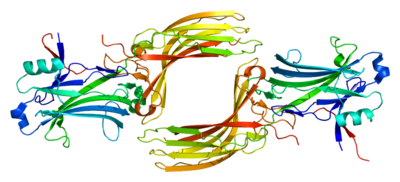
Search
Arrestin beta 1

Arrestin, beta 1, also known as ARRB1, is a protein which in humans is encoded by the ARRB1 gene.
Function
Members of arrestin/beta-arrestin protein family are thought to participate in agonist-mediated desensitization of G protein-coupled receptors and cause specific dampening of cellular responses to stimuli such as hormones, neurotransmitters, or sensory signals. Arrestin beta 1 is a cytosolic protein and acts as a cofactor in the beta-adrenergic receptor kinase (BARK) mediated desensitization of beta-adrenergic receptors. Besides the central nervous system, it is expressed at high levels in peripheral blood leukocytes, and thus the BARK/beta-arrestin system is believed to play a major role in regulating receptor-mediated immune functions. Alternatively spliced transcripts encoding different isoforms of arrestin beta 1 have been described, however, their exact functions are not known. Beta-arrestin has been shown to play a role as a scaffold that binds intermediates and may direct G-protein signaling by connecting receptors to clathrin-mediated endocytosis.
Interactions
Arrestin beta 1 has been shown to interact with
- Arf6,
- PTHLH,
- DVL2
- Mdm2,
- OPRD1,
- PSCD2, and
- RALGDS.
References
Further reading
External links
- Human ARRB1 genome location and ARRB1 gene details page in the UCSC Genome Browser.
Text submitted to CC-BY-SA license. Source: Arrestin beta 1 by Wikipedia (Historical)
Articles connexes
- Arrestin
- Arrestin beta 2
- G protein-coupled receptor kinase 2
- Μ-opioid receptor
- Alpha Arrestin
- Parathyroid hormone-related protein
- Beta-1 adrenergic receptor
- G protein-coupled receptor kinase 3
- Rod cell
- Beta-2 adrenergic receptor
- CYTH2
- Visual phototransduction
- DVL2
- Glucagon-like peptide-1 receptor
- Prostaglandin DP2 receptor
- G protein-coupled receptor kinase
- G protein-coupled receptor
- Rhodopsin kinase
- 25N-N1-Nap
- RALGDS
Owlapps.net - since 2012 - Les chouettes applications du hibou



